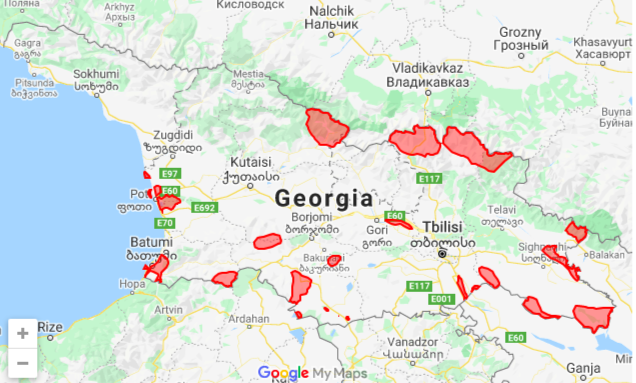Taxonomy
Kingdom Animalia (16266)Phylum Chordata (708)
Class Mammalia (111)
Order Artiodactila (12)
Family Bovidae (6)
Genus Capra (3)
Species Capra cylindricornis
Browse by taxonomy
Simple search by name
Capra cylindricornis ✓
Eastern Tur (East Caucasian tur), აღმოსავლეთკავკასიური ჯიხვი
Name According To: https://www.iucnredlist.org/species/3795/91287260
Species: cylindricornis
Taxon Rank: Species
Scientific Name Authorship: Blyth, 1841
Vernacular Name: Eastern Tur (East Caucasian tur)
Georgian Name: აღმოსავლეთკავკასიური ჯიხვი
GBD Remarks:
Conservation Status (International): IUCN status (international) EN A2ad ver 3.1 (Reduction in population size based on an estimated population size reduction of ≥ 50% over the last 10 years, where the reduction or its causes may not have ceased, based on direct observation and actual level of exploitation).
Conservation Status (national): Georgian Red List. IUCN National status (2006) EN A2ad ver 3.1 Pop. trend: decreasing (The species included in the IUCN Red List and reduction in population size based on an estimated population size reduction of ≥ 50% over the last 10 years, where the reduction or its causes may not have ceased, based on direct observation and actual level of exploitation). Prioritized for Action Plan development in the National Biodiversity Strategy and Action Plan for Georgia (2005).
Economic importance (national): interesting as an attraction for eco-tourists and scientists. Under heavy pressure from poaching. Important Folklore species.
Monitoring Methods: Surveys (distance sampling, aerial surveys); camera-trapping; genetic analyses; Habitat suitability modeling.
Research institutions: (1) ISU, Institute of Ecology, Institute of Zoology; (2) NACRES. contact – Zura Gurielidze, Natia Kopaliani, Alexander Gavashlelishvili (ILIAUNI), Bejan Lortkipanidze (NACRES).
Ongoing projects: Institute of Ecology at Ilia State University conducts monitorings in 2012-2013. Employed methods are aerial and land surveys.
Web links: http://www.biodiversity-georgia.net; http://www.iucnredlist.org/details/3795/0 ; http://nacres.org/lmam10.html
Relevant specific information: The extent of occurrence 20,000 km2. Reacheable range between valley of riv. Tergi in the west and Lagodekhi reserve in the east. Aerial counts in 2013, covering 73723 hectares, inferred average estimate of 1164 mature individuals throughout the studied area, extrapolated to ca. 3000 individuals for the national population. This is substantially lower that the prior (2009) estimate. The highest density has been recorded for Chkheri-Devdoraki area (estimate of 719 mature animals). Earlier estimates (http://nacres.org/lmam10.html) suggested presence of ca. 5000 individuals.
Why to monitor: Globally near threatened and nationally vulnerable. Key species in contributing to the formation of mountain ecosystems and an important item of national folklore
Preliminary suggestion: Organize existing data into a user-friendly format freely available on the Internet. Organize annual monitoring at several pre-defined sites in western and eastern parts of the Greater Caucasus within Georgia, using camera-traps and collecting scats for genetic studies. Monitoring requires two months per year, an expert and 3-4 students. Develop a spatial model of abundance dynamics
კონსერვაციული სტატუსი (საერთაშორისო) : IUCN სტატუსი: საფრთხის წინაშე მყოფი (NT) ვერსია 3.1 პოპულაციის რაოდენობა მცირდება.
კონსერვაციული სტატუსი (ეროვნული): საქართველოს წითელი ნუსხა, IUCN საერთაშორისო სტატუსი - მოწყვლადი (VU). კრიტერიუმი B1b(v) გეოგრაფიული არეალი 20 000 კმ2-ზე ნაკლებია და გრძელდება ზრდასრული ინდივიდების რიცხვის შემცირება. პრიორიტიზირებულია სამოქმედო გეგმის განვითარებისათვის საქართველოს ბიომრავალფეროვნების სტრატეგია და მოქმედებათა გეგმაში (2005).
ეკონომიკური მნიშვნელობა (ეროვნული): საინტერესო ობიექტია ეკო-ტურისტებისა და მეცნიერებისათვის. განიცდის ბრაკონიერობის მწვავე ზეწოლას.
საზოგადეობრივი ინტერესი: მნიშვნელოვანი ადგილი უჭირავს ეთნიკურ ფოლკლორში.
შესწავლის მეთოდიკა: აღრიცხვა (დისტანციური აღრიცხვა, აერო-ფოტო აღრიცხვა); ვიდეო-ხაფანგები, გენეტიკური ანალიზი, ჰაბიტატის მოდელირება. პოპულაციური მოდელირების განხორციელება შესაძლებელია კომპიუტერული პროგრამა DISTANCE (Bukland et al. 2001, Thomas, L., et al. 2010) მეშვეობით. აღნიშნული პროგრამა მუშაობს ვინდოუსის პლათფორმაზე (http://www.ruwpa.st-and.ac.uk/distanc/).
მიმდინარე კვლევა: (1) ილიას სახ. უნივერსიტეტის ეკოლოგიის და ზოოლოგიის ინსტიტუტი; (2) არასამთავრობო ორგანიზაცია ნაკრესი. საკონტაქტო პირი - ზურა გურიელიძე, ნათია კოპალიანი, ალექსანდრე გავაშელიშვილი (ილიაუნი), ბეჟან ლორთქიფანიძე (ნაკერსი). 2012 წელს საჰაერო და დისტანციური დაკვირვებები აწარმოა ეკოლოგიის ინსტიტუტმა (ილიაუნი), რომელიც დაფინანსებული იყო საქართველოს მთავრობის მიერ. ეკოლოგიის ინსტიტუტს ჰყავს სპეცისლისტები და სტუდენტები რომელთაც შეუძლიათ განახორციელონ მონიტორინგი.
სპეციფიკური ინფორმაცია: გავრცელების არეალი 20 000 კმ2-ზე ნაკლებია, მისაწვდომ ტერიტორიაზე ვრცელდება მდ. თერგის ხეობიდან აღმოსავლეთით ლაგოდეხის ნაკრძალამდე. 2013 წლის აერო-ფოტო აღრიცხვით, რომელიც მოიცავდა 73723 ჰექტარს, საშუალო აღრიცხული რაოდენობა 1164 ზრდასრული ინდივიდია. ხოლო გათვლითი რაოდენობა ეროვნულ დონეზე 3000 ინდივიდია. ეს რიცხვი ნაკლებია წინა აღრიცხვასთან (2009) შედარებით. ყველაზე მაღალი რიცხოვნობა დაფიქსირებულია ჩხერი-დევდორაკის ტერიტორიაზე (719 ზრდასრული ინდივიდი). ადრინდელი მონაცემებით, პოპულაცია ფასდებოდა როგორც დაახლ. 5000 ინდივიდის შემცველი (http://nacres.org/lmam10.html).
ვებ-გვერდი: http://www.biodiversity-georgia.net; http://www.iucnredlist.org/details/3795/0 ; http://nacres.org/lmam10.html
რატომაა საჭირო მონიტორინგი გლობალურად საფრთხის წინაშე მყოფი და ეროვნულ დონეზე მოწყვლადი. მთის ეკოსისტემების მნიშვნელოვანი კომპონენტი და მნიშვნელოვანი სიმბოლო ეთნიკურ ფოლკლორში.
წინასწარი რეკომენდაციები: არსებული ინფორმაციის ინტერნეტში განთავსება მომხმარებლისათვის ადვილად აღქმადი ფორმით. ყოველწლიური მობნიტორინგის ორგანიზება რამდენიმე წინასწარ განსაზღვრულ წერტილში, დიდი კავკასიონის ჩრდილოეთ და სამხრეთ ფერდობებზე, საქართველოს არეალის ფარგლებში, ვიდეო-ხაფანგების მეშვეობით და ესკრემენტების შეგროვება გენეტიკური ანალიზისათვის. მონიტორინგისთვის საჭიროა წელიწადში ორი თვე საველე სამუშაო, რომელშიც ერთი ექსპერტი და 3-4 სტუდენტი მიიღებს მონაწილეობას. დამხმარე მეთოდი - პოპულაციის სიმჭირდროვის მოდელირება.
Page Authors: Alexander Gavashelishvili ,
Reference of occurrence in Georgia: Bukhnikashvili, A. & Kandaurov, A., 2002. The annotated list of mammals of Georgia. Proceedings of the Institute of Zoology, Tbilisi, XXI: 319-336
Information from GBIF about Capra cylindricornis
GBIF scientific name: Capra cylindricornis (Blyth, 1841)
GBIF taxonomic status: SYNONYM

Conservation Status
This section is under construction
National Red List Status: EN
IUCN Red List Status: NT
Protection status: Not defined
Reason: B1;B2a
Trend: Declining
EOO: < 5000
AOO: <2000 კვ.კმ. (1200კვ.კმ) B2 (VU)
Endemism: Caucasus
Native/Introduced: Native
Comment: სტატუსი EN (გადაშენების საფრთხეში მყოფი) B1;B2a . ბრაკონიერობა შემცირებული, თუმცა გრძელდება. ჰაბიტატი ნაწილობრივ დეგრადირებულია. ლოკაციების რაოდენობა არ აღემატება 5-ს. IUCN-ის რეკომენდაციების მიხედვით სხვადასხვა კრიტერიუმების მისადაგებით მიღებული კატეგორიებიდან ვირჩევთ უმაღლესს.უახლოესი წყარო პოპულაციებიც არ არიან მრავალრიცხოვანები. ზაქათალას ნაკრძალში ერთ ზრდასრულ სქესმწიფე მდედრზე 2012 წლის მონაცემებით 0. 27 ერთი წლის ნაშიერი მოდიოდა, რაც პოპულაციის ზრდის დაბალ მაჩვენებელზე მეტყველებს.ტლიარატას აღკვეთილში 2017 წელს ჩატარებული აღრიცხვის თანახმად დაახლოებით 1000 ჯიხვი ბინადრობს.
Georgian Name: აღმოსავლეთკავკასიური ჯიხვი
English Name: Eastern Tur (East Caucasian tur)
Taxonomy according to: https://www.iucnredlist.org/species/3795/91287260
References: გურიელიძე ზ., კოპალიანი ნ., დეკანოიძე დ.,ნინუა ლ., ქერდიყოშვილი ნ.,პაპოშვილი ნ. 2014.ცხოველთა სამყაროს ობიექტების მონიტორინგის მიზნით აღრიცხვების ჩატარება საქართველოს ტერიტორიაზე აღმოსავლეთ კავკასიური/დაღესტნური ჯიხვის და არჩვის გავრცელების ადგილებზე.ილია
Evaluated By: Kopaliani N, Gurielidze Z
Date evaluated: Nov 2021






